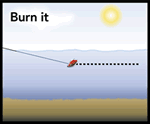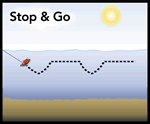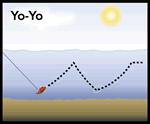
Retrieves: There are many different ways to work a Rat-L-Trap and using the right presentation can improve your day’s catch. Here are three of the very best techniques for Trap fishing. Burn It – This is by far the most popular method, a fast steady retrieve covering a lot of water. Many professional fishermen use this method and they call it “locating”. It will allow you to make a lot of casts in a short period of time, thus improving your chance of finding an area where fish are holding. This is an early spring favorite for covering shorelines were bass are spawning. Once you catch a fish, stay in that area and really give it a good work over. You most likely will pick up a couple of more fish in a short period of time. A high-speed reel is highly recommended when burning a Trap. Most reels today come with 5.3 to 1 ratios and are sufficient for this method. However a 6 to 1 ratio is better on your arm.
Stop & Go
When you reel in a Trap, slow or fast, stop the reel every 3 or 4 cranks of the reel handle. This will cause the lure to fall for a second simulating an injured baitfish. You can experiment with this technique by changing up the rhythm of your pause. This is a perfect technique to use where there is a target to throw at. If there is a laying log or a dock, run the Trap up to the log and pause the bait before and after the structure. You don’t need much of a pause; just a split second will allow the bait to fall a little. Be ready at that point, that’s usually when the strike will occur. Bill Lewis uses this method often; it’s one of his personal favorites.
YO-YO
Up and down, a very effective technique for deeper water presentations. Using your rod tip to make the lure rise and fall over structure. Keep in mind a Rat-L-Trap will fall at the rate of 1 1/2 ft per second. This will help you count the lure down to a certain depth. A good example is suspended fish at 15 feet on a graph. You could count to 10 and the Trap will most likely be right in th e zone for a strike. If a school is holding in deep water of a major point, try the technique and cover both sides of the point. It really helps if you know the depth of water on each side. If you’re in 20 foot of water, you may want to Yo-Yo the Trap from 5 to 15 feet. Remember, the size of your line will effect how fast a lure sinks. Heavy line will slow the fall rate down and small diameter will speed it up.
e zone for a strike. If a school is holding in deep water of a major point, try the technique and cover both sides of the point. It really helps if you know the depth of water on each side. If you’re in 20 foot of water, you may want to Yo-Yo the Trap from 5 to 15 feet. Remember, the size of your line will effect how fast a lure sinks. Heavy line will slow the fall rate down and small diameter will speed it up.
Size Selection
Down sizing or up-sizing your lure can make a big difference in your success any given day.
One of the most obvious reasons to change the size of a lure is to “match the hatch”. Pay close attention to the size of the prey the bass are feeding on. Shad come in all sizes and bass will gorge on them. If the shad are large, go to a lure close to that size, and vice versa.
Another situation, when size matters, is when weather conditions change. I’ve seen times where a 1/2 oz Trap was working great early in the morning, and a cold front passed through and shut things down fast. The bite went sluggish, as they say. Written by Tommy Martin. Read the rest of this great tip article at LBL………
.
